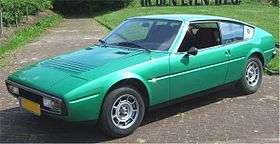Matra Bagheera
| Matra Bagheera | |
|---|---|
 | |
| Overview | |
| Manufacturer | Matra Automobiles |
| Also called | Matra-Simca Bagheera, Talbot-Matra Bagheera |
| Production | 1973–1980 |
| Designer | Antonis Volanis |
| Body and chassis | |
| Class | Sports car |
| Body style | 3-door hatchback |
| Layout | MR layout |
| Related | Simca 1100 Ti |
| Powertrain | |
| Engine |
1.3 L Poissy engine ohv I4 1.5 L Poissy engine ohv I4 |
| Transmission |
4-speed manual all-synchromesh[1] |
| Dimensions | |
| Wheelbase | 2,370 mm (93 in)[2] |
| Length | 3,974 mm (156.5 in)[2] |
| Width | 1,734 mm (68.3 in)[2] |
| Height | 1,175 mm (46.3 in)[2] |
| Curb weight | 965 kg (2,127 lb) [2] |
| Chronology | |
| Predecessor | Matra 530 |
| Successor | Matra Murena |

The Matra Bagheera is a sports car created by the French engineering group Matra in cooperation with the automaker Simca and design by Greek designer Antonis Volanis. It was marketed as Matra-Simca Bagheera to highlight the link, except for the final production year 1980, when it was re-badged Talbot-Matra Bagheera after Chrysler Europe's demise and subsequent takeover by PSA. Named after the panther from The Jungle Book, the Bagheera was created using stock Simca components, including the engines, gearbox and suspension elements, but unlike the Simca cars it shared them with, it was a mid-engined car (the Simcas in question, Simca 1100 and Simca 1307, were front-wheel drive).[3]
The Bagheera's body was made of polyester, mounted on a steel structure. It was formed in the shape of a sleek hatchback, with a rear hatch that allowed access to the engine mounted behind the passenger compartment. There was only one row of seats, but it featured an unusual combination of three abreast. The Bagheera remains one of the few three-passenger sports cars.[3]
When launched in 1973, the Bagheera was only available with the 1.3 L straight-4 engine, belonging to Simca's "Poissy engine". In 1975, the range was complemented by a 1.5 L version of the same engine. In 1976, the Bagheera underwent a major restyling, with basically only the rear hatch unchanged (Bagheera type II). Another change took place in 1978, when the dashboard was replaced again, and in 1979 the Bagheera was given conventional door handles in lieu of the previous "hidden" ones (Bagheera type III). Since PSA took control of Simca in the previous year (after the demise of Chrysler Europe), all Simcas were re-badged Talbot and Matra-Simca became Talbot-Matra.
Production of the Bagheera ended in 1980, when it was replaced by Matra Murena, with 47,802 Bagheeras built in total.[3]
The Bagheera is also notable as one of the few manufacturers in the world to have developed a "U engine" for this vehicle. As Matra engineers believed the Bagheera could use a more powerful unit, they created a unique construction out of two 1.3 L Simca straight-4 engines, joined side-by-side by a common pan unit, the two crankshafts being linked by chain. This resulted in a 2.6 L 8-cylinder unit, producing 168 bhp. However, Chrysler Europe (the parent company of Simca) was unwilling to pursue the project due to the developing fuel crises as well as its own financial problems. Thus, the U8-powered Bagheera remained as a prototype and only three units were ever built.[4]
Early in 1974 the German Magazine Auto, Motor und Sport tested a 1294 cc Bagheera, comparing it with obvious competitors in the process.[2] The car's light-weight body served it well in the performance comparisons: a top speed of 186.5 km/h (116 mph) was recorded as against 176.5 km/h (110 mph) for the Alfa Romeo GT 1300 Junior, despite the Alfa Romeo's claim of an extra 3 bhp.[2] The French car also beat the Milanese on acceleration, taking 12.2 seconds to reach 100 km/h (62 mph) as against the Alfa's 13.5 seconds.[2] The Matra-Simca's DM 14,198 price tag was usefully lower than the DM 14,490 listed for the Alfa Romeo, though both were undercut on price by models from mass market producers such as the 1900 cc Opel Manta SR at DM 13,990.[2]
Very few Bagheeras remain in existence today, as they were suffering badly from quality issues (the Bagheera won the ADAC Silberne Zitrone = "Silver Lemon" award in 1975 for the poorest quality car of that moment) and extensive body rot. Though the polyester panels couldn't rust, the underlying steel chassis had almost no protection.[5] Matra learned from this and fully galvanized the Bagheera's successor, Matra Murena.[6]
References
- ↑ "Autotest Matra-Simca Bagheera". Autocar. Vol. 143 (nbr 4107). 26 July 1975. pp. 65–68.
- 1 2 3 4 5 6 7 8 9 "Test Matra Simca Bagheera". Auto, Motor und Sport. Vol. Heft 3 1974. 2 February 1974. pp. 53–59.
- 1 2 3 "Matra-Simca Bagheera". Simca Talbot Information Centre – Simca Club UK. Retrieved 2006-08-19.
- ↑ "The Matra Bagheera U8 Project". Rootes-Chrysler.co.uk – Rootes Group, Chrysler Europe, SIMCA, and Talbot cars. Retrieved 2006-08-20.
- ↑ Matra Bagheera history matrasport.dk
- ↑ Knallgelbes Plastikmobil (in German)
External links
| Wikimedia Commons has media related to Matra-Simca Bagheera. |